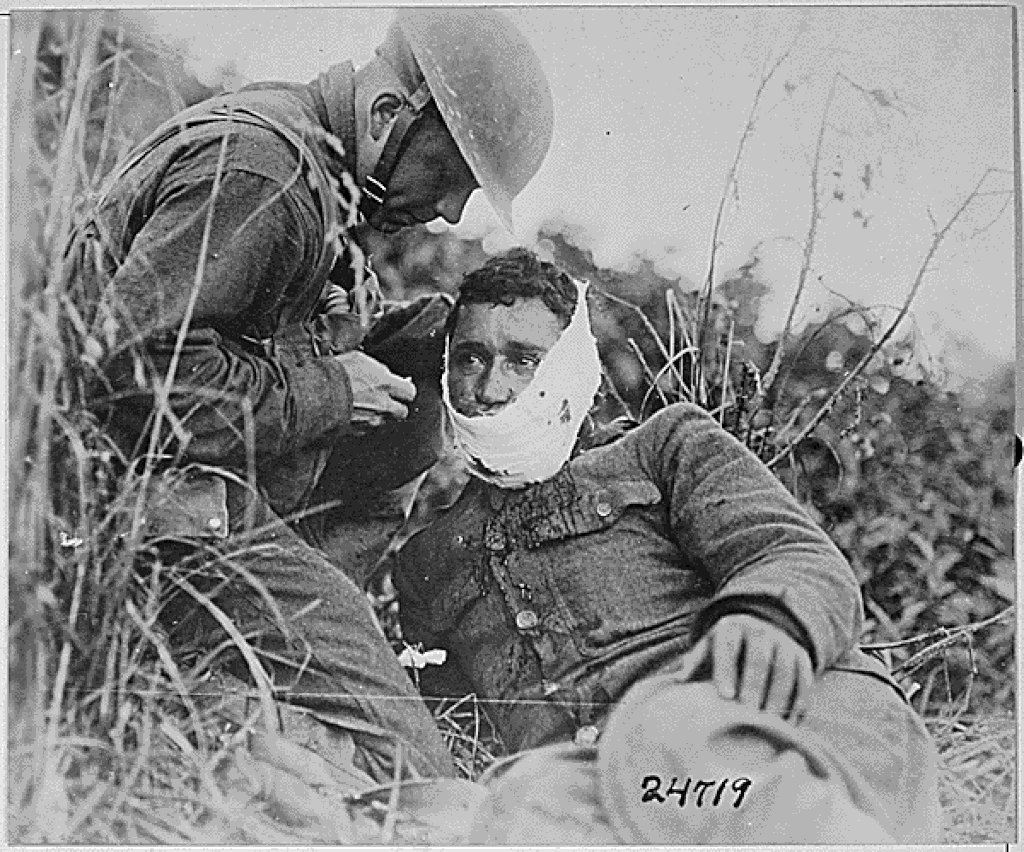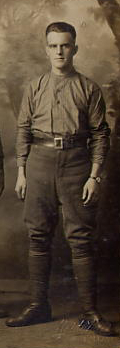This is the seventeenth in a series of columns about the 70 British Home Children sent to St. Patrick’s Catholic Orphanage in Prince Albert between 1901 and 1907. While all orphanage records were destroyed in the terrible fire of 1947, every attempt has been made to trace the life stories of these dispossessed children through genealogy websites and newspaper databases
Hildreth Castling: Shell Shocked
Hildreth Castling, a British Home Child who lived in the Prince Albert orphanage from 1903 to 1914, was one of the 24,029 casualties of the battles of the Somme in 1916. He was wounded on 26 September at the Battle of Thiepval Ridge near the village of Courcelette in France.
Buried alive by a shell explosion, Castling sustained a gunshot wound to his face which left him with a three-inch scar extending from the left corner of his mouth across his cheek. Worse, he had classic symptoms of shell shock, now known as post-traumatic stress disorder or PTSD.

A soldier receives treatment for a facial wound during the First World War.
Medical reports from 1917 and 1918 found in his service records, accessible on the website of Library and Archives Canada, show that in addition to his facial deformity, Castling was nervous, had tremors of the arms and hands, and had a marked speech impediment in the form of stuttering. He was discharged from the Canadian Army on 31 January 1918 and returned to Prince Albert. His medical condition, recorded on 18 September of that year states: “Headaches, slight at times. Noise or excitement causes him to become nervous and irritable. Sleeps well, appetite good. … Shell shock has slightly affected nerves but this condition improving. … Recommendations: Do no consider treatment necessary. Health fully recovered in about three months.”
Hildreth Castling was no stranger to adversity. He was born on 27 December 1895 in London, England, two months after his mother Johanna Elizabeth Kelleher (1875 – 1962) married Hildreth Castling (abt 1858-1899), 17 years her senior. Little Hildreth was first admitted to the Newington Workhouse, Westmoreland Road, Southwark with his mother (age 23, occupation: ironer), and younger sister Johanna on 19 October 1898. (The actor Charlie Chaplin spent a short time in Newington Workhouse in 1896.) A month earlier, Hildreth’s father had been admitted to the East Sussex Lunatic Asylum.
Hildreth’s father was transferred to the new Bexley Lunatic Asylum on 25 April 1899. A few days later, on 4 May, little Hildreth was admitted to the Newington Workhouse again, this time by himself. He was not yet four years old.
On 7 October 1899, Castling’s father died in the Bexley Asylum. According to the 1901 British census, Johanna Castling, a 25-year-old widow, was working as a servant in the home of the Galliano family in Croydon, Surrey. Her 5-year-old son Hildreth was in St. Joseph’s Home, a Catholic school in Holtwhites Hill, Enfield, Middlesex.
Hildreth’s hope for a “normal” family life ended when his mother remarried on 4 April 1902 to a soldier named Frederick Albert Griffiths. Presumably unwanted by his new stepfather, Hildreth was placed aboard the Bavarian on 15 October 1903 enroute to Canada with other British Home Children sponsored by the Catholic Emigration Society. Their destination was St. Patrick’s Catholic Orphanage in Prince Albert where he lived until he enlisted in the Canadian Expeditionary Forces in 1914.
After returning from the war, Castling moved to Saskatoon in 1919 and worked as a ticket seller and doorman at the Victoria Theatre, now the Coors Events Centre on Second Avenue, until 1925. He married Alice Carey Brockway in Saskatoon on 30 August 1920 and they had two children, Douglas Hildreth born in 1921 and Bernice Evelyn born in 1923. Castling remained in Saskatoon until 1942 where he was employed at various clubs, pool rooms and billiard halls.
The Castling family moved to New Westminster, British Columbia in 1942 where Hildreth Sr. secured employment at the Heaps Engineering Company, a manufacturer of war materials. His wife Alice worked in the company’s blueprint department. Their son Hildreth Jr. fought overseas during the Second World War. He lost a leg when his plane was shot down over Germany in 1943. Young Castling was captured by the Germans and fabricated his own artificial leg while in the POW camp.
Hildreth Castling died at age 57 on 19 December 1953 in White Rock, BC and buried at Surrey Centre Cemetery, Surrey, BC, Block 291-4. He was survived by his widow, his son Hildreth, his daughter Mrs. B. Killeen, his mother Johanna Griffiths (who died at age 87 in London, England), three brothers and a sister in England.


